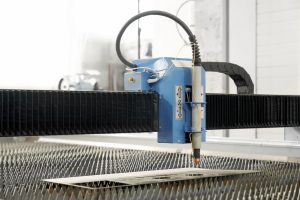Garnet dust is an often-overlooked byproduct in many industrial settings. Commonly used in abrasive blasting and waterjet cutting, garnet particles can accumulate quickly and pose significant risks. Understanding the sources and dangers of garnet dust can help you take the necessary precautions to protect your equipment and workers.
Ignoring garnet dust can result in severe consequences. This dust can contaminate the work environment, posing health risks to workers exposed to it over long periods. Moreover, when equipment gets clogged with garnet dust, its performance drops, affecting productivity. You can maintain a cleaner, safer, and more efficient workplace by recognising the importance of controlling this dust.
Understanding Garnet Dust and Its Sources
Garnet dust forms during industrial processes that use garnet as an abrasive material. Abrasive blasting and waterjet cutting are common methods for breaking garnet into fine particles. These processes are efficient for cutting and cleaning but produce a significant amount of fine dust.
The dust can become airborne or settle on various surfaces, including machinery and workspaces. Airborne garnet dust can spread quickly, especially in confined spaces, making it hard to control without proper ventilation. This widespread dispersal means garnet dust can reach areas beyond the immediate worksite, increasing the need for comprehensive dust control measures.
Additionally, dust can settle into crevices and equipment components, creating a layer of fine particles that can build up over time. Identifying and understanding where this dust comes from helps tackle the problem more effectively. Knowing the sources allows for better preventive actions and a more efficient cleanup process.
Risks Posed by Uncontrolled Garnet Dust
Uncontrolled garnet dust can cause various problems for industrial equipment and work environments. One of the most significant risks is component wear and tear. Fine particles can infiltrate moving parts, causing abrasive damage. This can lead to increased maintenance costs and shorten the lifespan of machinery.
Another risk is contamination. Garnet dust can contaminate products and production lines, affecting quality and safety standards. This can result in product recalls or rework, both costly and time-consuming for any business.
Worker health is also a major concern. Inhaling garnet dust over prolonged periods can cause respiratory problems. Ensuring that the dust is effectively removed protects the health of all employees on-site. Keeping work areas clean and contaminant-free maintains a safer and healthier environment.
Furthermore, poor air quality due to dust accumulation can affect overall productivity. Workers may need to take more breaks, and equipment might need to be shut down for cleaning, leading to production delays. Recognising the risks of uncontrolled garnet dust underlines the importance of regular and thorough dust removal.
Benefits of Professional Garnet Dust Removal
Hiring professionals for garnet dust removal offers many advantages. First, experts use specialised equipment to remove dust safely and effectively. This ensures that all particles are extracted, preventing damage to machinery and maintaining a clean worksite.
Another key benefit is compliance with safety standards. Professional services follow strict guidelines to manage and dispose of garnet dust, which helps businesses meet regulatory requirements. This reduces the risk of fines and legal issues related to improper industrial waste handling.
Professionals also help improve operational efficiency. By eliminating dust buildup, machines work better and need less maintenance. This boosts productivity and reduces downtime. A clean work environment enhances worker health and morale, leading to higher performance.
Steps to Prevent Garnet Dust Accumulation
Preventing dust accumulation is essential for maintaining a safe and efficient workspace. Here are some steps to keep your site clean:
1. Regular Cleaning
Schedule regular clean-up sessions to remove dust from all surfaces. This reduces buildup and makes deep cleaning easier.
2. Ventilation Systems
Install and maintain proper ventilation systems to capture airborne dust. This helps control dust spread and keeps the air clean.
3. Protective Covers
Cover machinery and equipment to prevent dust from settling in hard-to-clean areas. This protects sensitive parts from abrasive damage.
4. Routine Inspections
Regularly identify areas where dust accumulates quickly. Address these spots promptly to prevent further buildup.
5. Worker Training
Train employees on the importance of dust control and best practices for keeping their workstations clean. This promotes a culture of cleanliness and safety.
Following these steps, businesses can minimise garnet dust accumulation, protect equipment, and maintain a healthy workspace.
Conclusion
Managing garnet dust is crucial for keeping industrial equipment in top shape and ensuring a safe working environment. From understanding its sources to recognising the risks and benefits of professional removal, each step contributes to a cleaner, more efficient operation. Regularly cleaning and maintaining equipment and using professional services can greatly reduce the dangers of garnet dust.
Garnet dust removal is essential for businesses dealing with abrasive materials. If you need expert assistance, contact iVAC WA for top-quality garnet dust removal service. Our team specialises in safely and efficiently extracting garnet dust, helping you maintain a clean and compliant workspace. Reach out to iVAC WA today and secure a healthier, more productive environment for your business.

